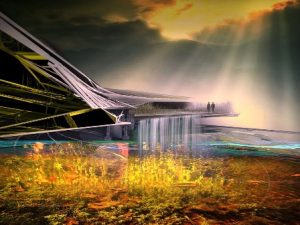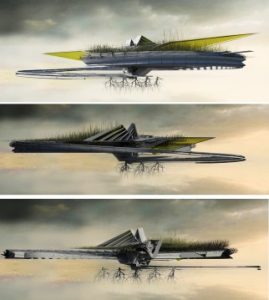Self-Excavation Hurricane House
Located near the Louisiana coastline, the hurricane house has a long history of hurricanes and also has many destructive effects. The ocean storms stimulate falling on the state from the coast of Africa (where they are formed) due to Louisianna’s location along the Gulf of Mexico that is bordering the Atlantic as per information available via v2com.
According to some records, these hurricanes spin around the eye of the storm. These hurricanes rotate in the same direction i.e. anti-clockwise in the northern hemisphere and clockwise in the Southern hemisphere.

Well, the nature of the hurricane is important to determine the design criteria.
Hurricanes consist of a ring of thunderstorms extending up to 15 km’s known as the eyewall. This is where the heaviest rain and strongest winds which can exceed 120 miles an hour rotate. The scheme uses the hurricane’s strength to slowly turn part of the structure along its helicoid retaining wall, burying itself as it turns by using wind direction to mobilize its hydraulic pivots.
To face the environmental loads such as winds, this house has been built flexible enough to move with a hurricane, but it is strong enough to withstand into its own excavated engineered landscape.
The house has a main superstructure which holds the living accommodation, it can move along a helicoid retaining wall, excavating as it does so. The building’s core is a reinforced concrete anchor under which a grid of root-like cable foundations spread, pinned into the landscape this anchor supports the superstructure by using a series of hydraulic column lifts which pivot to turn the building, excavating its own substructure as the main living area moves, the immediate context provides different levels into which the building can rotate, burying itself into the already partly excavated landscape to protect itself from the hurricane. The architecture is choreographed by the wind direction of the hurricane, turning with it.
The dug ground formed is pushed away, while the artificial island that surrounds the building acts as a covering that moves water away from the building.

The island’s floor plate panels line the solar panels and bounded by a ring of turbines. Sixty-four separate timber sections are contained in the turntable like design thing that acts as an irrigation field that directs floodwater and rain away from the building. These contained sections are very much closer to the building to help improve the drainage system, as they act like a water screw.
The main living space of the building is formed from a precast reinforced concrete frame. This concrete frame is very lightweight in structure and has a series of concertina wall sections that are rubber-coated, which provides flexibility to accommodate during the building’s circulation and movement needs.
The house is surrounded by an artificial island, which is decorated to keep flush flood water at bay from the main living area. The topsoil that surrounds the house navigates rain and flood water to drain into the deeper soil just like the bioswale. A constructed wetland is built by the macrophyte plants, and this ecological resident benefits the land restoration and water purification to conquer any floodwater pollutants that come from the hurricane.
The temporarily stored floodwater and wetland absorbs are released slowly to avoid any major damage to the surrounding area.
The force from which the hurricane comes does not use extreme pressure build up as it flies over and around the whole building. However, the building’s movement indicates the consuming force as the scheme twists. The dead load present in the building gives it an ability to turn very slowly only when exposed to winds that rotate over 70 miles an hour without damaging further to the structure. It is also fast enough to ignore the hurricane’s full force.
On the behalf of the Yunnan metallurgical group, this commission’s concept and origin were for a spa in Kunming, China. Due to the client’s interest in the research of renewable energy, the location has also been changed.

About Margot Krasojevic Architects: Margot Krasojevic has been developing a dialogue between architectural form, geometry, sustainability and smart materials as an inherent part of the design process, dictating the terms of the architectural design criteria rather than referring to sustainable technology as a polite afterthought. Renewable energy and how to optimize the collaboration between program, typology and architecture has always been at the forefront of the studio’s research and design approach. Following her Masters and PhD in 1997 and 2003 respectively architecture has become the tool through which to explore environmental change and renewable energy sources.
Photo credits: Margot Krasojević via v2com

